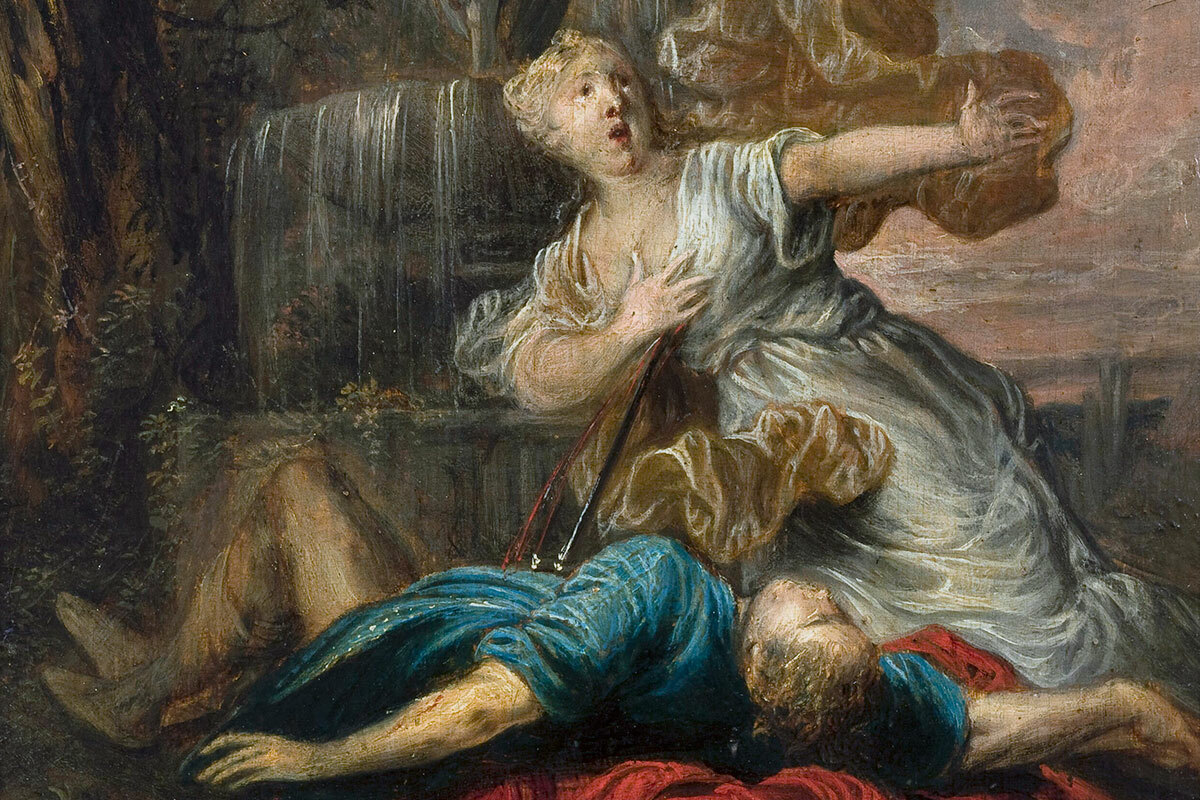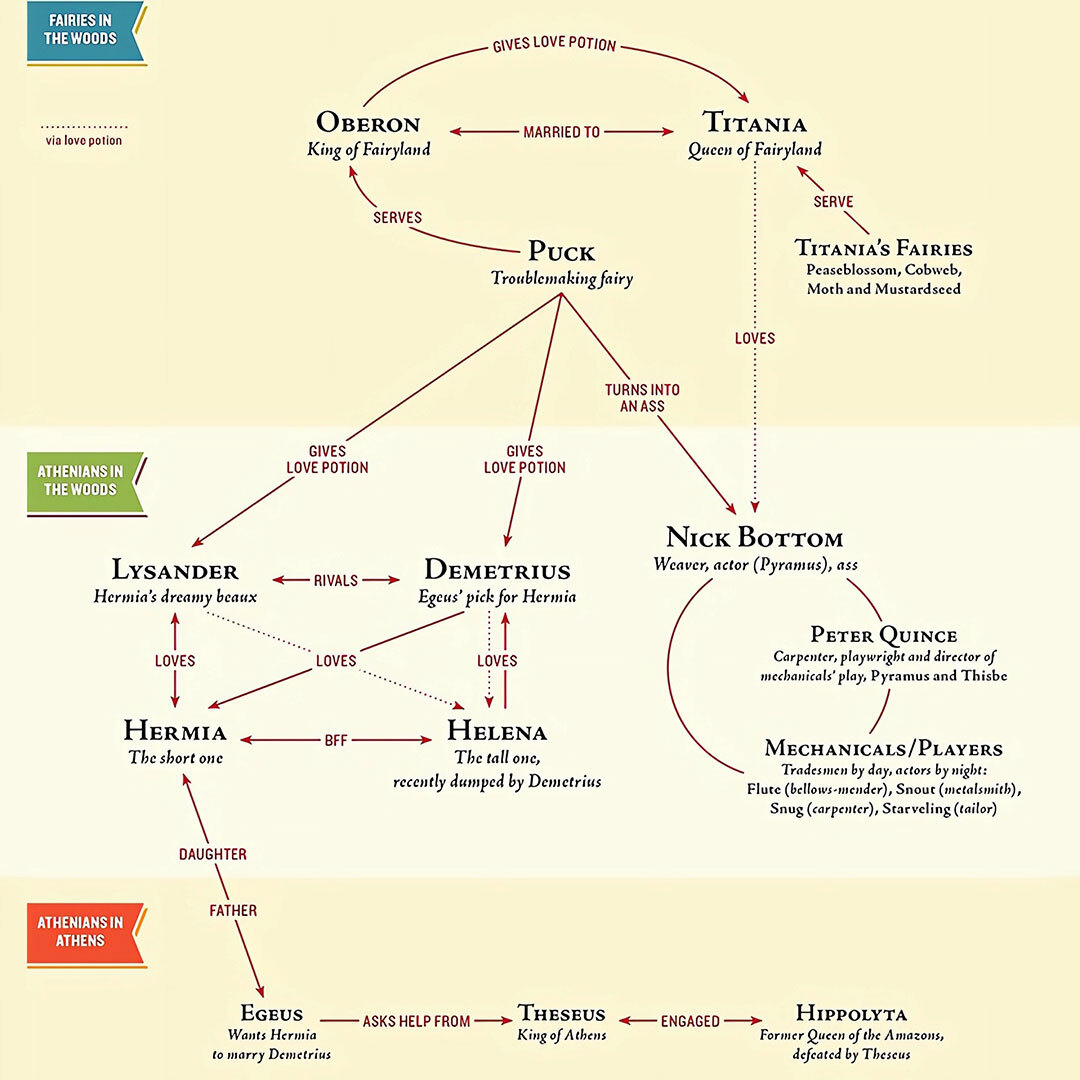A Most Lamentable Comedy: The Play-Within-a-Play
Though not invented by William Shakespeare, the “play-within-a-play” is famously employed by the Bard in several of his 38 plays (or 39, depending on who’s counting). Some scholars believe that Thomas Kyd was the first to use this device in his play entitled The Spanish Tragedy in around 1587. Coming from the French saying mise en abyme, or “placed into abyss” – metadrama appears in Hamlet, The Taming of the Shrew, Love’s Labour’s Lost, The Tempest, and A Midsummer Night’s Dream.
The play in Midsummer is a crude retelling of the story of Pyramus and Thisbe, which may have existed in an oral tradition before but is credited to Ovid and is believed to have first been published in 8 CE as part of the epic poem Metamorphoses. The poem consists of 250 myths, 15 books, 11,995 lines, and chronicles history from the myth of creation to the deification of Julius Caesar. Many writers pulled from this epic for elements of their storytelling — none quite so much as Shakespeare, who would have read the tome in grammar school. In “The Ovidian Elements in ‘A Midsummer Night’s Dream,’” Walter F. Stanton Jr. writes:
“That Ovid’s influence might be very strong in A Midsummer Night’s Dream should surprise no one. The play’s date (1594-1596) is close to the dates of such works as Venus and Adonis (1593), The Rape of Lucrece (1594), and Romeo and Juliet (ca. 1595), in which Shakespeare was most under the influence of Ovid. The same period saw a rash of Ovidian imitation in England: between 1593 and 1595 were written Marlowe’s Hero and Leander, Drayton’s Piers Gaveston and Endimion and Phoebe, Dickenson’s Arisbas, Heywood’s Oenone and Paris, Chapman’s Ovids Banquet of Sence, Campion’s Poemata … to name only the most striking examples. Certainly, by 1595 or 1596, Ovid was ripe for parody.”
A Midsummer Night’s Dream contains elements from several of Metamorphoses’ books, namely Book III which introduces the character of Diana from whom Titania may be derived, Book VII which features stories about Theseus, Book XV which tells the story of Hippolytus, the son of Theseus and Hippolyta and Book IV which contains the story of Pyramus and Thisbe.
This aetiological myth, or origin myth, is meant to explain the color of the fruit of a mulberry tree. Two lovers living in Babylon in adjoined houses are forbidden by their feuding parents to be together and only communicate through a crack in a wall between the two properties. They arrange to meet under a mulberry tree. Thisbe, who arrives first, is frightened away by a lioness with a bloody mouth. As she flees, her cloak is left behind and the lioness rips it apart. When Pyramus arrives, he takes the bloody cloak as a sign that Thisbe has been killed by the lion and kills himself with a sword, his blood spattering the mulberry tree and turning its fruit red. Thisbe returns, prays to the gods to keep them together always, and stabs herself with the same sword. The gods honor her request and permanently change the color of the mulberry tree to commemorate their love.
We can see a clear connection from this story to that of Romeo and Juliet — Shakespeare’s enduring tragedy — which was likely written around the same time he was penning Midsummer. The inclusion of Pyramus and Thisbe in Midsummer, however, is less tragic and becomes as Peter Quince describes it in the play a “most lamentable comedy.” The ill-fated lovers in Midsummer do not come to ruin as they do in Ovid’s story or in Shakespeare’s Romeo and Juliet and instead the bungling players who gather in the woods provide the Duke and Duchess on their wedding day a “very notably discharged” performance which delights the nobles.
It is believed that A Midsummer Night’s Dream was written to be performed at a nobleman’s wedding, though there is little evidence as to whose, and therefore Shakespeare’s play-within-a-play may have reflected his own metatheatrical reality. While he would have had the likes of The Chamberlain’s Men to perform his interlude, the “rude mechanicals'' who perform The Most Lamentable Comedy and Most Cruel Death of Pyramus and Thibse for Theseus and Hyppolyta’s nuptials are of a different sort. The ragtag band of common folk are pulling from a pre-Elizabethan tradition of mystery plays which were plays devised from biblical stories and performed by craftspeople. In Midsummer, these amateur dramatists make their living as carpenters and woodworkers — tailors and tinkers and bring with them into the enchanted forest a love for their chosen theatrical craft and prove yet again in their offering that “the course of true love never did run smooth.”
Portland Center Stage is committed to identifying & interrupting instances of racism & all forms of oppression, through the principles of inclusion, diversity, equity, & accessibility (IDEA).
















